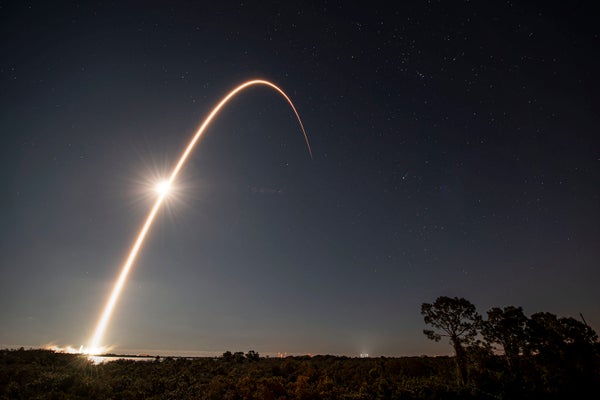A prime ground-based observatory that scans the sky for exploding stars and dangerous near-Earth asteroids is struggling with disruptive light streaks from SpaceX's Starlink internet satellite constellation, a new study revealed.
The observatory, called the
Zwicky Transient Facility (ZTF), opened its telescope eye in California in 2017. Scanning the entire sky every two days, the observatory looks for the temporary brightening or sudden appearance of objects that remain visible only briefly. It hunts for supernova explosions of dying stars and asteroids passing close to Earth.
On supporting science journalism
If you're enjoying this article, consider supporting our award-winning journalism by subscribing. By purchasing a subscription you are helping to ensure the future of impactful stories about the discoveries and ideas shaping our world today.
A new review of its observations going back to 2019, the year when SpaceX began launching its ambitious
Starlink megaconstellation, has revealed that a considerable percentage of the telescope's views has streaks in it caused by the satellites as they passed overhead.
Images capturing the twilight sky around sunrise and sunset are the most affected, the team behind the new study said
in a statement. These observations are particularly important for spotting potentially dangerous asteroids coming from the direction of the sun, the scientists added.
The ratio of affected twilight images has risen steeply with the growth of the Starlink megaconstellation from only 0.5% in late 2019 to 20% in late 2021. But only a fraction, about 15%, of SpaceX's envisioned constellation of up to 12,000 satellites are currently in orbit, suggesting the ultimate impact will be much larger. Moreover, SpaceX hopes to eventually expand the size of its internet-beaming fleet to a whopping 42,000 spacecraft. And there are other companies with similar plans including OneWeb, Amazon or China's SatNet.
To date, SpaceX has 1,469 active Starlink satellites and
just launched 49 new satellites late Tuesday (Jan. 18), the company's second Starlink launch of 2022.
"We don't expect Starlink satellites to affect non-twilight images, but if the satellite constellation of other companies goes into higher orbits, this could cause problems for non-twilight observations," Przemek Mróz, the lead author of the study and former postdoctoral scholar at California Institute of Technology (Caltech), which runs ZTF, said in the statement.
Overall, the scientists found 5,301 satellite streaks on observations from the studied period.
Not everything is doom and gloom, however. The study also found that since SpaceX started installing
visors on its satellites, the brightness of the craft went down by a factor of five and so did that of the streaks.
Caltech physics professor Tom Prince, a co-author of the study, added that only about 0.1% of pixels in an image are damaged by the streak.
"There is a small chance that we would miss an asteroid or another event hidden behind a satellite streak, but compared to the impact of weather, such as a cloudy sky, these are rather small effects for ZTF," he said in the statement.
Astronomers have been concerned about the potential impact of Starlink satellites on new discoveries since the first batch reached orbit in May 2019. At first, many skywatchers were in awe at the spectacular
string of pearls crossing the sky after the launch, but that awe was only shortlived.
Since then, the International Astronomical Union has called on the United Nations to
protect pristine night sky as human heritage, and a recent workshop of the American Astronomical Society compared the potential damage megaconstellations can cause to astronomy to that caused by light pollution.
The controversial technology has many opponents among space safety experts as well. According to Professor Hugh Lewis, Europe's lead authority on space debris, Starlink satellites are now
responsible for more than 50% of collision risk situations between two satellites in orbit.
Scientists studying Earth's atmosphere are worried about the possible effects megaconstellation satellites may have on the planet's climate. Megaconstellation operators such as SpaceX plan to regularly replace their technology with newer models and deorbit the old used satellites for burn-up in Earth's atmosphere. This burn-up, however, will
produce potentially dangerous particles that might have unforeseen effects on the planet.
The ZTF study was published in the Astrophysical Journal Letters on Monday (Jan. 17)
